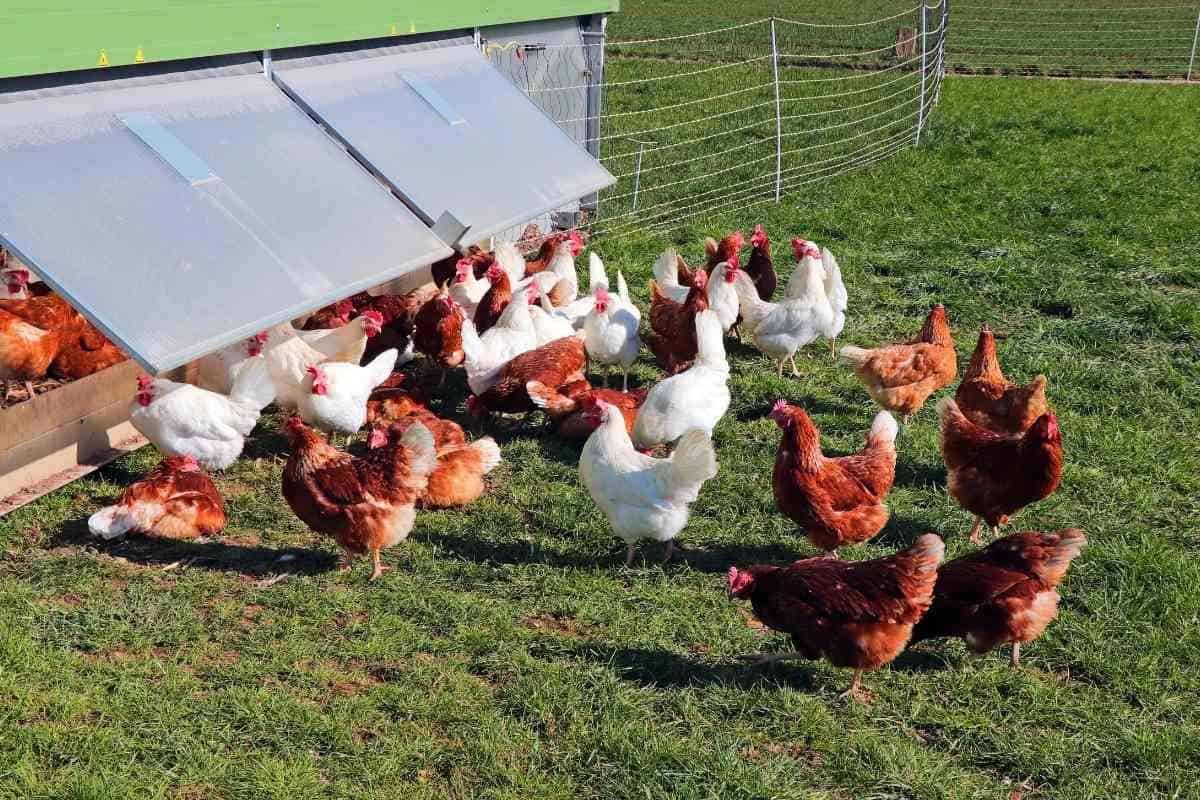5 Creative Ways To Make Money On 10 Acres Of Land
Owning land can be a great investment, but finding creative ways to make money on just 10 acres of land can be tough. You may be wondering how you can make money from just 10 acres of land. Maybe you’ve been told that making a living from such a small plot of land is impossible.

How can you make money on 10 acres of land?
You can make money off just ten acres of land in several creative ways. You can raise livestock, open a small farm stand, rent your land, offer horse riding lessons or even start a CSA. If you have the space and the resources, there are endless possibilities for generating income from your land.
If you’re like most people, the idea of owning 10 acres of land is pretty appealing. It’s enough space to do whatever you want, and there are plenty of creative ways to make money from it! In this article, we will explore ten creative ways to make money on 10 acres of land. Whether you’re looking to start a farm, raise livestock, or just find a creative way to make some extra cash, we have you covered.
We spent countless hours scouring the internet for the best ways to make money on just ten acres of land, and we think you’ll be surprised at what we found.
Is 10 Acres Enough to Farm?
The first question you might be asking is whether or not ten acres is enough to farm. The answer is yes! You can easily farm ten acres of land with proper planning and management.
You’ll need to consider what crops you want to grow, how you will need irrigation, and how much labor you’re willing to put in. However, if you’re willing to put in the work, farming ten acres of land can be a great way to make money.
Make Money Off The Land: Multiple Options To Consider
If you are thinking about buying land or you already own land. Learn how to maximize your earnings from the land in these popular articles in our series about making money living off the land.
How Many Acres Do You Need to Farm to Make Money?
How much land do you need to farm to make money? The answer may surprise you. While there are many factors to consider, including the type of crop you are growing and the market conditions, it is possible to profit from farming just a few acres of land.
In fact, many small farmers are finding that they can compete with larger operations by being more efficient and focused in their approach.
A report from the University of Nebraska-Lincoln found that an acre of corn can yield an average gross income of $673. This figure does not take into account the cost of seed, fertilizer, and other inputs, but it does show that there is potential for profitable farming, even on a small scale.
How Much Can You Make Off an Acre of Farmland?
The answer to this question depends on a number of factors, including the type of crop you are growing, the yield you can expect, the market conditions, and your costs. For example, if you grow wheat on your farmland, you can expect to make about $500 per acre. If you grow corn, you can expect to make closer to $1,000 per acre. And if you grow specialty crops like tobacco or tea, you can easily make over $5,000 per acre. Of course, these are just averages – your actual earnings will vary depending on the individual market conditions.
Editor’s Pick: Suggested Reading
Learn More: Start A Hunting Club or Invest in Hunting Land
What Is the Most Profitable Crop Per Acre?
When it comes to profitability, not all crops are created equal. While some crops may yield a large quantity of food, they may be less valuable in terms of the market price. Other crops may be more rare or difficult to grow, making them more valuable per acre. When considering the most profitable crop per acre, it is important to take into account both the quantity and quality of the crop.
One crop that is often cited as being highly profitable is tobacco. Tobacco is a relatively easy crop to grow, and it commands a high price per pound on the open market.
Another crop that is often profitable is mushroom. Mushroom cultivation can be more difficult than other crops, but they are often sold at a premium price.
Bamboo is another crop that can be very profitable due to the fact that it is a versatile material that can be used for a variety of purposes. Bamboo grows quickly and can yield many usable products per acre.
5 Creative Ways to Make Money On 10 Acres of Land
1. Grow Small Acreage Crops
Growing small acreage crops is a great option if you’re looking for a way to make some extra money from your land. Not only is it relatively simple to get started, but you can also grow various crops, depending on your climate and preferences. There’s something for everyone from vegetables and fruits to herbs and flowers.
Plus, you can sell your crops at local farmers’ markets, restaurants, and grocery stores. So if you have a green thumb and some basic gardening knowledge, this could be a great money-making venture for you.
Let’s go over some of the most common crops you can grow on ten acres of land:
Garlic

If you want to add a little flavor to your life and bank account, consider planting some garlic. This potent little vegetable is a staple in many kitchens worldwide and is relatively easy to grow.
You can get started with just a small space, and one acre of garlic can yield anywhere from 700-2000 pounds. That’s a lot of garlic! At $0.50-$0.70 per pound, you could make $1000-$1400 from just one acre of garlic.
Garlic is a hardy plant that can tolerate a wide range of climates, but it grows best in well-drained soil with full sun exposure. To maximize yield, it is important to choose a high-quality garlic variety and to plant the cloves at the correct depth.
With proper care, your garlic crop will be ready to harvest in just a few months. So if you’re looking for a way to add some spice to your life, consider planting some garlic. It’s easy to grow and can be very profitable.
Mushrooms
While most people think of mushrooms as a type of plant, they are actually a type of fungi. Fungi are classified as their own kingdom, separate from plants and animals. Mushrooms are the reproductive structure of fungi, and they can be found in a wide variety of habitats, from the forest floor to your kitchen countertop. While some mushrooms are poisonous, many are edible and can be a delicious addition to any meal.
Mushrooms are fairly easy to grow and can be grown indoors or out. They do not require soil and can instead be grown in straw or manure. One acre of mushrooms can yield anywhere from 500-1000 pounds, which can be sold for $0.50-$0.70 per pound. With proper care, a mushroom crop can provide a steady income for years to come.
Herbs
Herbs are a versatile and valuable crop that can be easily grown on a small farm. For culinary purposes, common herbs such as basil, thyme, and oregano can add flavor to any dish. More exotic herbs such as saffron and cardamom can be used in specialty dishes and fetch a higher price. Medicinally, herbs have been used for centuries to treat various ailments.
Some common medicinal herbs include chamomile, lavender, and mint. Herbs can also be used for decoration, with many varieties boasting beautiful flowers or colorful leaves. Many herbs are quite valuable, with some fetching upwards of $50 per pound
Herbs are relatively easy to grow and can be started from seeds, cuttings, or divisions. They can be grown in the ground or in containers, and most do best with full sun exposure. One acre of herbs can yield a large quantity of product, which can be sold fresh, dried, or processed into oils or other products. With proper care, an herb farm can provide a steady income for years to come.
Grapes for Wine
If you have a green thumb and a love of wine, then growing wine grapes may be the perfect way to make money on a small plot of land. Though the initial investment can be significant, the profits from selling grapes can be substantial.
And, as any wine lover knows, the value of a good bottle of wine only increases with time. With proper care, a grapevine can produce fruit for decades, making it a wise investment for the future.
Wine grapes are a relatively easy crop to grow, but they do require some special care. Grapevines need to be pruned regularly to encourage healthy growth and maximum yield. They also need to be protected from pests and diseases, which can be challenging in some climates. With proper planning and care, a small vineyard can provide a viable source of income for years to come.
Flowers
Flowers are a beautiful and popular crop that can add color and life to any farm. Though they are often considered luxury items, the truth is that flowers are in high demand, especially during peak wedding and event seasons. And, with proper care, a flower farm can provide blooms year-round.
Many different types of flowers can be grown on a small acre of land, from popular varieties such as roses and tulips to more exotic blooms such as orchids and lilies. Flowers can be grown in the ground or in containers, and most do best with full sun exposure.
One acre of well-managed flower beds can yield a large quantity of product, which can be sold fresh or processed into bouquets, wreaths, or other arrangements.
2. Raise Livestock

Many different types of livestock can be raised on 10 acres of land, from chickens and ducks to cattle and pigs. Each animal type has its unique set of requirements, so be sure to do your research before deciding which one is right for you.
Raising livestock can be a lot of work, but it can also be very rewarding. And, of course, it can be a great way to make some extra money.
Let’s go over a few of the most common livestock animals that can be raised on a small farm:
Broiler Chicken
Broiler chickens are a type of chicken that is specifically raised for its meat. Unlike other types of chickens, which are bred for their eggs, broiler chickens are typically slaughtered at a young age. As a result, they have tender flesh that is perfect for cooking.
Broiler chickens can be raised in a small space and require minimal care, making them a popular choice for many farmers. In addition, they are relatively inexpensive to purchase and feed, making them a budget-friendly option for families.
The main concern with raising broiler chickens is ensuring enough food and water. Otherwise, they will quickly become sick and may not reach their full size. For this reason, it is important to consult with a veterinarian or poultry expert before raising broiler chickens. However, if done correctly, raising broiler chickens can be a fun and rewarding experience.
Tilapia Farming
Tilapia is a type of fish popular for its mild flavor and versatility. It can be cooked in many different ways and is a good source of protein. Tilapia farming is a relatively new industry, but it has grown in popularity in recent years. This is because tilapia can be raised in small spaces and do not require special equipment or care. In addition, tilapia is fast-growing and have a high yield, making them a profitable choice for farmers.
If you are interested in raising tilapia, you should know a few things. First, tilapia need warm water to survive, so they are not well-suited to cold climates. Second, they require a high level of dissolved oxygen in the water, so they must be kept in an aerated tank.
Finally, tilapia are sensitive to changes in temperature and pH, so it is important to monitor these levels carefully. With proper care, tilapia can be a profitable and rewarding addition to any farm.
Guinea Fowl
Guinea fowl are a type of bird that is native to Africa. They are known for their flavorful meat, which has a slightly gamey taste. Guinea fowl are also popular for their eggs, which are larger than chicken eggs and have a richer flavor.
In addition, guinea fowl are relatively easy to care for and do not require much space. For these reasons, they have become a popular choice for many farmers.
As with any animal, there are some things to consider before raising guinea fowl. First, they require a lot of space – at least four square feet per bird. Second, they should be given plenty of time to roam and explore. Third, they can be noisy, so prepare for early morning wake-ups. But it can net you a higher price per pound.
Honey Bees
Honey bees are small insects that are known for their honey-making abilities. Honey bees are essential to the pollination of many crops, including fruits, vegetables, and nuts. In addition, they produce delicious honey that can be used in many different ways.
Honey bees can be kept on any size farm, making them a popular choice for farmers with limited space.
Caring for honey bees is relatively simple – they just need access to water and pollen. However, there are a few things to consider before getting started.
First, having enough hives to support the number of bees is important. Second, the hives should be placed in an area with plenty of flowers and plants. Finally, honey bees are susceptible to disease, so it is important to monitor their health closely.
3. Rent/Sell A Part of Your Land or Mineral Rights
Unless you’re planning to build on your land or use it for farming or ranching, there’s a good chance that it’s just sitting there collecting dust.
But did you know that your land can actually be quite valuable, even if you’re not using it? If you’re open to the idea of renting out a portion of your land or selling the mineral rights, you may be surprised at the income you can generate. In many cases, people are willing to pay good money for the privilege of using your land for their own purposes. This is a great way to make money without putting in any work.
If you choose to rent out your land, you can do so for a variety of purposes, such as farming, grazing, or recreation. The amount you charge will depend on the size of the land and its location. If you live in an area with a lot of hunting, for example, you may be able to charge more for hunters to use your land. Similarly, you could charge fishermen for access if your land is located near a popular fishing spot.
You can also rent out your entire property for events such as weddings, birthday parties, or family reunions. This can be a great way to earn some extra money and show off your beautiful land.
Selling the mineral rights to your land can also be a great way to generate income. Minerals are natural resources found underground and used for various purposes, such as construction or manufacturing. If you own the minerals rights to your land, you have the legal right to extract and sell them. The amount of money you can make from selling mineral rights will vary depending on the type and quantity of minerals on your land.
So if you’re looking for a way to generate some extra income, don’t overlook the value of your land. With a little effort, you may be able to turn your idle property into a profitable venture.
4. Offer Horseback Riding Lessons
Horseback riding is a popular hobby for many people, but it can also be a great way to make money. If you have experience with horses and are comfortable working with beginners, you could offer horseback riding lessons.
This is a great way to earn some extra income while doing something you love.
There are a few things to consider before offering horseback riding lessons. First, you will need to have access to a horse or horses.
You can own your own horse or lease one from a local stable. Second, you will need to have proper liability insurance in place in case of accidents. Finally, you will need to market your services to potential customers. Once you’ve taken care of the logistics, you’ll be ready to start teaching people how to ride.
Horseback riding lessons can be a great way to earn money, but they are also a lot of work. If you’re up for the challenge, though, it can be a fun and rewarding experience.
5. Start A Bed & Breakfast or Airbnb On Your Property
If you have a spare room or two, why not put them to good use? You can start a bed and breakfast or Airbnb and welcome guests from all over the world. This is a great way to meet new people and earn some extra income. Just be sure to check with your local laws and regulations first.
6. Start A CSA
Community-supported agriculture (CSA) is a great way to connect with members of your community and provide them with fresh, local produce.
CSAs typically involve farmers offering shares of their crops to community members at the beginning of the growing season. Members then pay upfront for their share, which entitles them to a certain amount of produce throughout the season.
Starting a CSA is a great way to earn extra income and build relationships with community members. But before you get started, there are a few things to keep in mind. First, you’ll need to determine how much produce you can realistically provide.
This will help you set expectations and avoid over-committing yourself. Second, you’ll need to develop a marketing plan. This may include creating flyers or posters, setting up a website, or distributing information at local events. Finally, you’ll need to decide on a pricing structure that covers the costs of running your CSA while still providing good value for members.






